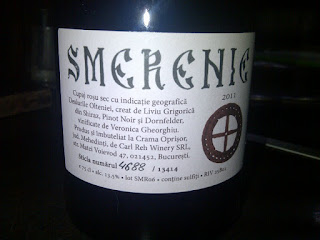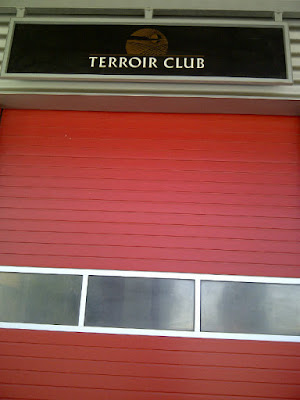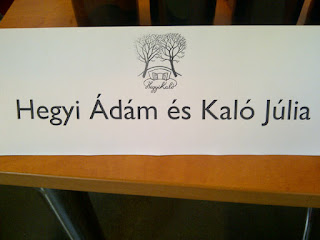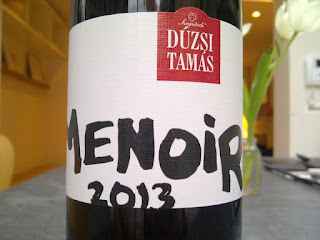In Romania for a wedding. Most of our time was spent in the German city of Brasov. The architecture and street names are still German. One of the interesting anomalies of this still very Latin country. Others include the Romanian Orthodox Church (very near to Greek and Russian Orthodox to our eyes and ears), the folk music (still Turkish influenced), the food (anything but Italian) and so forth. It is also recognizably Hapsburg in some respects.
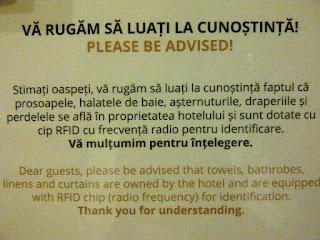 |
| A notice in our hotel room rather re-enforcing a Romanian stereotype? |
Romanians like to say that under Communism everyone had plenty of money but there was nothing to buy in the shops. Now there is an enormous choice of goods but no money.
Taking advantage of the cheapest taxi fares anywhere, we were able to check out two rather far-flung wine shops, Ethic Wines and Wine Republic. Sadly, Ethic only opened at 12.00pm.
The windows promised the best selection of Romanian wines but we couldn't wait so it was off to Wine Republic on what seemed the edge of town in a shopping centre.
This kind of address is not unusual even in more prosperous countries but being in a rush with the taxi waiting we failed to take any pictures while there which is a pity because the representative was highly knowledgeable and very helpful.
We were on the lookout for some seriously obscure grape varieties;
Tamaioasa Romanesca
Busuioaca de Bohotin
and were not disappointed, except for the fact that Tamaioasa Romanesca actually turns out to be Muscat Blanc a Petits Grains. Busuioaca de Bohotin may be a colour mutation of Muscat Blanc a petits grains or possibly a unique variety. Further work needs to be done. Any volunteers?
On top of these was a rather serious (and expensive) Marselan of all things (successful cross between Cabernet Sauvignon and Grenache grown more and more in Provence and it seems elsewhere).
 |
| Prince Stirbey himself? |
Now to backtrack, before going to Romania we had stopped by the Romanian Wine table at the SITT Wine Fair at Horicultural Halls, London about a fortnight previously. There was very handily an entire table devoted to Romanian wines.
This is a site where as well as praising diversity, we love to overthrow preconceptions. Our preconceptions of Romanian wine has centered around the not always exciting Feteasca varieties, Alba and Neagra and inexpensive but not bad Pinot Noir. An article by Jancis Robinson zeroing in on Prince Stirbey wines made other varieties sound more enticing so approaching the Romanian Winemakers stand, we were excited to see what must have been Prince Stirbey himself; a very tall and distinguished gentleman standing there dispensing his wines.
It turned our that this gentleman is an Austrian lawyer, Baron Jakob Kripp who is married to a lady, (Ileana) whose ancestor was Prince Stirbey.
Their winemaker is Oliver Bauer whose wines were on sale in Romania alongside those he makes for Prince Stirbey. Mr. Bauer is German. He belongs to a long line of German and Austrian winemakers to move to this part of the world. They are particularly evident in Hungary but are percent here too in Romania.
There is even a company called Schwaben Wein who make very decent (Romanian) Merlot among other wines. The term demisec seems to correspond to the German 'halbtrocken' so these wines are 'off dry' rather than semi-sweet. Romanian sweet wines (and there is a fair share of these) are 'dulce'.
Stirbey have a broad range of really interesting native varietal wines:
White
Feteasca Regala
Tamaioasa Romanesca
Cramposie Selectionata
Red
Feteasca Dragosani
Novac
We have managed to take home most of these and look forward to trying them out. Some of the wines are already imported into the UK. We found Feteasca Regala and Cramposie Selectionata and Novac especially good and interesting.
At Bistrot Guxt (No. 1 in Tripadvisor's Bucharest restaurants) we found a 2007 Stirbey Novac with the old label.
This might have been one of the best wines ever produced in Romania according to the marvelous and talented owner of Bistrot Guxt, Radu Popovici. While a wine expert of authority, Radu is actually a beer man with a passion for various styles of beer including English ones being produced locally (Romanian Bitter!).
From what we drank in Romania, we can report that Feteasca Regala outperformed Feteasca Alba and Cramposie Selectionata was a very worthwhile discovery. Among the reds, Novac stood out over Feteasca Neagra. We are not as familiar with Neagru de Dragosani as we would like to be having had just a small mouthful at SITT. It seemed promising nonetheless.
If you think an idiosyncratic pattern is emerging here, you would be right. As with the variegated character of Romania itself, the wine are taking their own course and it is not yet possible to know how the cards will fall eventually.
There were plenty of wines from international varieties but some interesting blends as well as the native grape varieties and surprising plantings (Marselan) mentioned above.
The cuvee here is Shiraz, Pinot Noir and Dornfelder. Original.
The airport at Bucharest is a good place to buy Romanian wine but only with Euros. We found some rarities among the inevitable Dracula Feteasca Neagras and Cabernet Sauvignons.
The first rarity was a Mustoasa de Maderat
Next a Sarba
Then, Stirbey's Tamaioasa Romaneasca. This is pretty good for an Airport Duty Free. Maybe not on the same level as at the Budapest Duty Free but better than any UK Duty Free, let's face it.
So from our short visit, we might conclude that Romania is an extremely interesting place from many points of view including their wines. They might not be as rich in diversity as their neighbour Hungary but pretty good. They certainly have potential, some of which is already being realized. So they merit greater appreciation and recognition. Hedre is a list of some of the indiginous varieties of Romania:
Babaesca Neagra
Busuioaca de Bohotin
Cadarca si Steinschiller (Steinschiller is 'Kovidinka in German!)
Feteasca Alba
Feteasca Dragosani
Feteasca Neagru
Feteasca Regala
Francusa (aka. Mustoasa de Moldova)
Galbena de Odobesti
Grasa de Cotnari
Iordana
Majarca Alba (ancient Balkan variety producing generally uninspiring whites. aka, Slankemenka
Mustoasa de Maderat
Novac
Plavaie (said to be no longer cultivated but still grown by Podgoria Odobesti (bless them!)
Sarba
Zghihara de Husi
Romanian wine production is both ancient and very modern. As with all the East European countries producing wine, the modern era dates from 1989 and the fall of communism. Since then people have clawed their way back to becoming a great wine producing nation again which is fitting for what was in 2014 the 12th biggest producer in the world, ahead of New Zealand, Greece, Hungary and Bulgaria and only just below the likes of Portugal, Germany, Chile and South Africa in terms of quantity. Now we can see what they can do qualitatively.
Important producers include
Alcovin - Crama Macin
Alira
Avincis
Budureasca
Casa de Vinuri Husi
Casa de Vinuri Nachbil
Casa de vinuri Olteanu
Casa de Vinuri Pietroasa
Casa Isarescu
Casa Panciu
Castel Vinum
Compania viticola Corcova
Cotnari
Crama Apcovin
Crama Averesti
Crama Basilescu
Crama Francu
Crama Liliac
Crama Voievodului
Cramele Halewood
Cramele Minis - Wine Princess
Cramele Rotenberg
Davino
Domeniile Anastasia
Domeniile Boieru - Ciumbrud
Domeniile Clos des Colombes
Domeniile Blaga
Domeniul Coroanei
Domeniile Dealu Mre - Urlati
Domeniile Franco-Romane
Domeniile Ostrov
Domeniile Shateni
Domeniile Samburesti
Domeniile Stirbey
Domeniile Tohani
Domeniile Viticole Sara
Domeniul Coroanei Segarcea
Domeniul viticol Saru
Lacerta
Liliac
Oenoterra Dealu-Mare
Petro Vasel
Podgoria Jidvei
Podgoria Valaha Cotesti
Recas
SCDVV Pietroasa
SD Banu Maracine
Senator Wine
Tenuta Odobesti
Valea Calugareasca
Veritas Panciu
Vie Vin Vanju Mare
Villa Vinea
Vinarte
Vincon Vrancea
Vinia
Vin Com Copu
Vinterra International
Vinvico
Viticola Sarica Niculitel
WineRo Aliman
Zarea


















